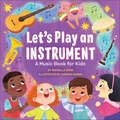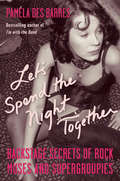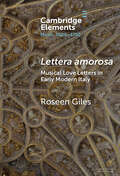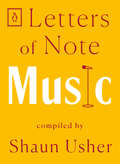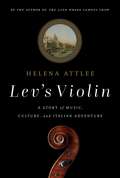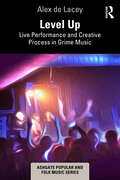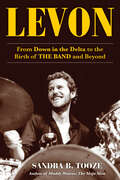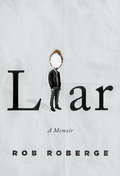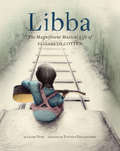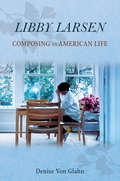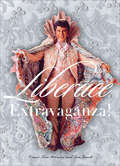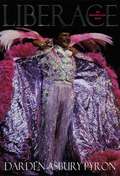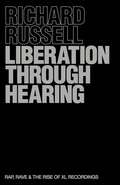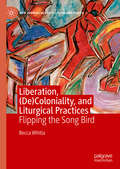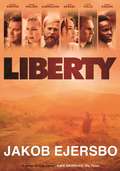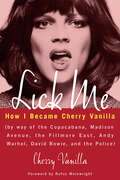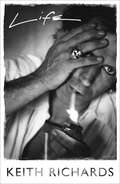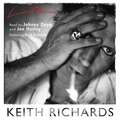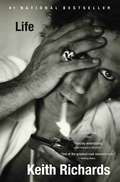- Table View
- List View
Let's Play an Instrument: A Music Book for Kids
by Rachelle BurkIntroduce kids to music, instruments, and rhythm with this adorable picture book for ages 3 to 5Get little toes tapping with this delightful music book for toddlers! On every page, simple language and big, beautiful illustrations teach little ones about woodwind, string, brass, and percussion instruments. They'll learn what each one is called, how it works, the sounds it makes, and why it helps make music so amazing!How music is made—Explore all the sounds instruments can create, from the deep rumble of the bass to the jingle of the tambourine.A magical, musical story time—Make reading aloud a musical adventure with rhythmic language that preschool and kindergarten kids will want to read again and again.Instrumental illustrations—This book about music features colorful, full-page illustrations convey the fun of playing music and are sure to delight kids and parents alike.Let little ones take their first steps in music with Let's Play an Instrument.
Let's Spend the Night Together: Backstage Secrets of Rock Muses and Supergroupies
by Pamela Des BarresThis intimate account of 24 legendary groupies reveals what went on behind the closed doors of rock stars from Elvis to Marilyn Manson. Consisting of Pamela Des Barres's revealing interviews with and profiles of other supergroupies, this book offers firsthand glimpses into the backstage world of rock stars and the women who loved them. The groupies--such as Tura Satana, Miss Japan Beautiful, who taught Elvis how to dance; Cassandra Peterson (Mistress of the Dark), who tangled with Tom Jones in Sin City; Cynthia Plaster Caster, who redefined the art of Jimi Hendrix; and Miss B., who revealed Kurt Cobain's penchant for lip gloss and panty hose--tell tales that go well beyond an account of a one-night stand to become a part of music history.
Let's Tune Up
by R. Annabel Rathman John W. Travis Paul HumeLet's Tune Up, A Study Course for Students of Piano Technology by John W. Travis
Lettera amorosa: Musical Love-Letters in Early Modern Italy (Elements in Music, 1600-1750)
by Roseen GilesIn early modern Italy, letters were not only written and read but, in some cases, sung. Musical settings of love letters rekindled a complex kind of vocality which was rooted in the letters of antiquity and endured in the musical sub-genre of the lettera amorosa. Epistolary poetry served to transform, or, to echo Achillini's lettera set by Monteverdi (1567–1643), to 'distill' a lover's thoughts and emotions into verse, and the music that set it was equally transformative. The history of musical letters spans several centuries. It begins in the early sixteenth with a setting of Ovid's Heroides by Tromboncino; returns in the early seventeenth through the lettere amorose of Monteverdi, D'India, and Frescobaldi; and ends with epistolary cantatas by Carissimi, Melani, and Domenico Scarlatti. This Element traces the breadth and significance of the musical love letter with a focus on the provocative lettere amorose of the seventeenth century.
Letters of Note: Music (Letters of Note #2)
by Shaun UsherFrom Beethoven and Tchaikovsky to John Lennon Prince and Kim Gordon, tune in to the evocative expressions of treasured composers, musicians, singers, and songwriters in this enchanting volume from the compiler of the bestselling Letters of Note collectionsVerdi writes to his publisher about a man who hated Aida so much that he wants his money back. Keith Richards tells his aunt about bumping into a former schoolmate named Mick Jagger, who also loves Chuck Berry. Yo-Yo Ma wonders whether Leonard Bernstein remembers introducing him onstage as a young boy. A Harvard psychiatrist begs CVS to change their on-hold music. Riffing on their passions and surroundings, the artists and entertainers in this volume candidly reveal the sources of their inspiration, what music means to them, why they create it, and so much more. This rich and engaging collection of 30 letters celebrates the resonance that music, in its many forms and variations, brings to our lives.
Letters of Note: Music (Letters of Note)
by Shaun UsherAn inspired and inspiring collection of letters on the theme of music, from the curator of the globally popular Letters of Note website.The first volume in the bestselling Letters of Note series was a collection of hundreds of the world's most entertaining, inspiring, and unusual letters, based on the seismically popular website of the same name--an online museum of correspondence visited by over 70 million people. From Virginia Woolf's heartbreaking suicide letter, to Queen Elizabeth II's recipe for drop scones sent to President Eisenhower; from the first recorded use of the expression 'OMG' in a letter to Winston Churchill, to Gandhi's appeal for calm to Hitler; and from Iggy Pop's beautiful letter of advice to a troubled young fan, to Leonardo da Vinci's remarkable job application letter. Now, the curator of Letters of Note, Shaun Usher, gives us wonderful new volumes featuring letters organized around a universal theme.In this volume, Shaun Usher turns to music in all its forms. Music elicits the full range of emotion from the human heart: from joy to despair, humour to awe. Letters of Note: Music brings together a riveting collection of letters by and about musicians and music that enrich our lives. Includes letters by Charles Mingus, Helen Keller, Nick Cave, Roger Taylor, Angelique Kidjo, and many more.
Letters to Kurt
by Eric ErlandsonA poetic elegy for Kurt Cobain from the man who created the band Hole with Cobain's wife Courtney Love. "Nearly two decades after the death of Kurt Cobain, a friend and fellow musician not only continues to mourn his suicide, but also rages against the culture that he holds responsible. These 52 'letters' . . . combine the subject matter of the Byrds' 'So You Wanna Be a Rock and Roll Star' with the fury of Allen Ginsberg's Howl . . . A catharsis for the writer and perhaps for the reader as well." --Kirkus Reviews "A touching and enlightening collection of prose poems addressed to [Erlandson's] departed friend." --The San Francisco Bay Guardian "Erlandson finally comes to terms with his loss in 52 prose-poem letters ostensibly addressed to Cobain in which he straightforwardly confronts his inner demons while offering personal reflections on food, drug abuse, death, and self-sabotage."--Booklist "The reverberations of Kurt's suicide last to this day, and have touched the lives of many. Dozens of people could have written their own version of this bracingly candid book; Eric Erlandson has written one, filled with rage and love, landmined with detail, that can stand for them all." --Michael Azerrad, author of Come As You Are: The Story of Nirvana "Eric was the spirit-boy in the Nirvana/Hole dynamic. Quiet, bemused, intelligent, and curiously intuitive to the power of hugging the devil, to say we will all be okay . . . Eric expresses how enchanting Kurt was, how the whole scene was, with his thoughtful, radical adult/prose love. Bring on the future, darling."--Thurston Moore, musician "Eric. He was always there: supportive, observing, in the thick of it. Hidden in plain sight . . . Without him, I can't imagine Seattle or L.A. or a dozen other places. This book is beautiful, brutal, brief. Happy-sad eloquence. Boy Scouts playing with the complimentary cologne in the heart of the ghost town. Listen to the man. He knows." --Everett True, author of Nirvana: The Biography Letters to Kurt is an anguished, angry, and tender meditation on the octane and ether of rock and roll and its many moons: sex, drugs, suicide, fame, and rage. It's part Dream Songs, part Bukowski, Ferlinghetti, Ginsberg, and the Clash. Rants, reflections, and gunshot fill these fifty-two prose poems. They are raw, funny, sad, and searching. This will make a beautiful book for anyone who loved Nirvana and Hole and the time and place when their music changed everything. Ultimately, it's an elegy for Kurt and the "suicide idols" who tragically fail to find salvation in their amazing music.
Let’s Talk About Pep
by Sandy Pepa DentonShe's the spiciest ingredient in the legendary rap group Salt-N-Pepa, and the outspoken star of VH1's smash-hit reality show. She's Sandy "Pepa" Denton -- and she's never at a loss for words. Now, in her first tell-all book, Pepa talks about sex, music, life, love, fame, and so much more. . . . "Most of you know me as Pep, or Pepa, the fun-loving half of Salt-N-Pepa. I am the party girl, the one who is down for whatever. But behind the laughs and the smiles is a whole lot of pain. "Funny, fearless, and full of life, Sandy "Pepa" Denton is a pop culture icon whose remarkable story is every bit as captivating and provocative as her Grammy Award-winning music. This is the real Pepa -- upfront, uncensored, unstoppable -- and these are the memoirs of a true pioneer, fighter, survivor, and inspiration to women everywhere. For the first time, Pepa talks about: Her troubled childhood Surviving abuse Her first encounters with Cheryl "Salt" James Salt-N-Pepa's instant success Her failed marriages and her escape from domestic abuse Her "breakup" with Salt and their eventual "reunion" Her triumphant comeback on the VH1 reality showsThe Surreal Life,Fame Games, andThe Salt-N-Pepa ShowFilled with surprising insights, outrageous anecdotes, and celebrity cameos -- including Queen Latifah, Martin Lawrence, Janice Dickinson, Omarosa, Missy Elliott, L. L. Cool J, supermodel Caprice, Ron Jeremy, Lisa "Left Eye" Lopez, "Spinderella," and many others --Let's Talk About Pepoffers a fascinating glimpse behind the fame, family, failures, and successes of celebrity. . . and into the faithful heart of a woman who will always value the good friends she found along the way. In the words of Sandy "Pepa" Denton, "there's no walking away from that. "
Lev's Violin: A Story of Music, Culture and Italian Adventure
by Helena AttleeInstantly entranced by the captivating voice of a violin, the author of The Land Where Lemons Grow takes us on a journey through five centuries of Italian history and culture to discover the stories embodied in this sensual instrument.From the moment she hears this violin for the first time, Helena Attlee is captivated. She is told that it is no ordinary violion. It's known as "Lev's Violin" and it is an Italian instrument, named after its former Russian owner. Eager to discover all she can about its ancestry and the stories contained within its delicate wooden body, she sets out for Cremona, birthplace of the Italian violin. This is the beginning of a beguiling journey whose end she could never have anticipated. Making its way from dusty workshops, through Alpine forests, cool Venetian churches, glittering Florentine courts, and far-flung Russian flea markets, Lev's Violin takes us from the heart of Italy to its very furthest reaches. Its story of luthiers and scientists, princes and orphans, musicians, composers, travellers and raconteurs swells to a poignant meditation on the power of objects, stories and music to shape individual lives and to craft entire cultures.
Level Up: Live Performance and Creative Process in Grime Music (Ashgate Popular and Folk Music Series)
by Alex de LaceyGrime music has been central to British youth culture since the beginning of the 21st century. Performed by MCs and DJs, it is an Afrodiasporic form that developed on street corners, on pirate radio and at raves. Level Up: Live Performance and Creative Process in Grime Music offers the first long-form ethnographic study of grime practice; it questions how and why artists do what they do; and it asks what this can tell us about creative process and improvisation more widely. Based on research conducted in London’s grime scene—facilitated by the author’s long-standing role as a DJ and broadcaster—this book explores the form’s emergence before taking a magnifying glass to the contemporary scene and its performance protocol, exploring the practice of key artists and their crews living and working in the city. The resultant model of creative interaction provides a comprehensive mapping of collective social learning in London’s informal cityscape, offering new ways to conceptualise improvisatory practice within ensembles.
Levon: From Down in the Delta to the Birth of THE BAND and Beyond
by Sandra B. ToozeThe life of the legendary drummer and singer is explored through extensive research and personal interviews with family, friends, and fellow musicians.In the Arkansas Delta, a young Levon Helm witnessed &“blues, country, and gospel hit in a head-on collision,&” as he put it. The result was rock 'n' roll. As a teenager, he joined the raucous Ronnie Hawkins and the Hawks, then helped merge a hard-driving electric sound with Bob Dylan's folk roots, and revolutionized American rock with the Band. Helm not only provided perfect &“in the pocket&” rhythm and unforgettable vocals, he was the soul of The Band.Levon traces a rebellious life on the road, from being booed with Bob Dylan to the creative cauldron of Big Pink, the Woodstock Festival, world tours, The Last Waltz, and beyond with the man Dylan called &“one of the last true great spirits of my or any other generation.&” Author Sandra B. Tooze digs deep into what Helm saw as a devastating betrayal by his closest friend, Band guitarist Robbie Robertson—and Levon&’s career collapse, his near bankruptcy, and the loss of his voice due to throat cancer in 1997. Yet Helm found success in an acting career that included roles in Coal Miner&’s Daughter and The Right Stuff. Regaining his singing voice, he made his last decade a triumph, opening his barn to the Midnight Rambles and earning three Grammys.
Liar
by Rob RobergeA darkly funny, intense memoir about mental illness, memory and storytelling, from an acclaimed novelist. When Rob Roberge learns that he's likely to have developed a progressive memory-eroding disease from years of hard living and frequent concussions, he is terrified by the prospect of becoming a walking shadow. In a desperate attempt to preserve his identity, he sets out to (somewhat faithfully) record the most formative moments of his life--ranging from the brutal murder of his childhood girlfriend, to a diagnosis of rapid-cycling bipolar disorder, to opening for famed indie band Yo La Tengo at The Fillmore in San Francisco. But the process of trying to remember his past only exposes just how fragile the stories that lay at the heart of our self-conception really are. As Liar twists and turns through Roberge's life, it turns the familiar story of sex, drugs, and rock 'n' roll on its head. Blackly comic and brutally frank, it offers a remarkable portrait of a down and out existence cobbled together across the country, from musicians' crashpads around Boston, to seedy bars popular with sideshow freaks in Florida, to a painful moment of reckoning in the scorched Wonder Valley desert of California. As Roberge struggles to keep addiction and mental illness from destroying the good life he has built in his better moments, he is forced to acknowledge the increasingly blurred line between the lies we tell others and the lies we tell ourselves.From the Hardcover edition.
Libba: The Magnificent Musical Life of Elizabeth Cotten
by Laura VeirsElizabeth Cotten was only a little girl when she picked up a guitar for the first time. It wasn't hers (it was her big brother's), and it wasn't strung right for her (she was left-handed). But she flipped that guitar upside down and backwards and taught herself how to play it anyway. By age eleven, she'd written "Freight Train," one of the most famous folk songs of the twentieth century. And by the end of her life, people everywhere—from the sunny beaches of California to the rolling hills of England—knew her music. This lyrical, loving picture book from popular singer-songwriter Laura Veirs and debut illustrator Tatyana Fazlalizadeh tells the story of the determined, gifted, daring Elizabeth Cotten—one of the most celebrated American folk musicians of all time. Plus, this is the fixed format version, which looks almost identical to the print edition.
Libby Larsen: Composing an American Life
by Denise Von GlahnLibby Larsen has composed award-winning music performed around the world. Her works range from chamber pieces and song cycles to operas to large-scale works for orchestra and chorus. At the same time, she has advocated for living composers and new music since cofounding the American Composers Forum in 1973. Denise Von Glahn 's in-depth examination of Larsen merges traditional biography with a daring scholarly foray: an ethnography of one active artist. Drawing on musical analysis, the composer 's personal archive, and seven years of interviews with Larsen and those in her orbit, Von Glahn illuminates the polyphony of achievements that make up Larsen 's public and private lives. In considering Larsen 's musical impact, Von Glahn delves into how elements of the personal ”a 1950s childhood, spiritual seeking, love of nature, and status as an important woman artist ”inform her work. The result is a portrait of a musical pathfinder who continues to defy expectations and reject labels.
Liberace Extravaganza!
by Connie Furr Soloman Jan JewettKnown for his spectacular performances, the magnificent Wladziu Valentino Liberace was a world-renowned star in the entertainment industry for more than four decades, and his dazzling, often outrageous costumes are what made him most memorable. In Liberace Extravaganza! the entertainer's sequined, bejeweled, and rhinestone-studded outfits, as well as his extravagant collection of furs, feather capes, sparkling bow ties, and custom-made shoes are exhibited in book form for the very first time.These mesmerizing costumes grew from Liberace's humble beginnings when, as a young man, he would perform in his brother's hand-me-downs. From there, his suits, worth as much as twenty-four thousand dollars, featured layers of silk and satin ruffles, Swarovski crystal rhinestones, and fourteen-karat white-gold, diamond-encrusted buttons, culminating in his "electric" costumes with four thousand light bulbs weighing more than twenty-five pounds.Michael Travis, Liberace's principal designer, has written the foreword for this breathtaking volume. Jim Lapidus, another of Liberace's designers, furrier Anna Nateece, and Ray Arnett, his producer, have contributed original sketches used to design Liberace's costumes. The result is a book that is one of a kind: a celebration of the legendary performer and a visual feast of the most extraordinary costumes ever created.With more than 260 full-color photographs
Liberace: An American Boy
by Darden Asbury PyronMore people watched his nationally syndicated television show between 1953 and 1955 than followed I Love Lucy. Even a decade after his death, the attendance records he set at Madison Square Garden, the Hollywood Bowl, and Radio City Music Hall still stand. Arguably the most popular entertainer of the twentieth century, this very public figure nonetheless kept more than a few secrets. Darden Asbury Pyron, author of the acclaimed and bestselling Southern Daughter: The Life of Margaret Mitchell, leads us through the life of America's foremost showman with his fresh, provocative, and definitive portrait of Liberace, an American boy. Liberace's career follows the trajectory of the classic American dream. Born in the Midwest to Polish-Italian immigrant parents, he was a child prodigy who, by the age of twenty, had performed with the Chicago Symphony Orchestra. Abandoning the concert stage for the lucrative and glittery world of nightclubs, celebrities, and television, Liberace became America's most popular entertainer. While wildly successful and good natured outwardly, Liberace, Pyron reveals, was a complicated man whose political, social, and religious conservativism existed side-by-side with a lifetime of secretive homosexuality. Even so, his swishy persona belied an inner life of ferocious aggression and ambition. Pyron relates this private man to his public persona and places this remarkable life in the rapidly changing cultural landscape of twentieth-century America. Pyron presents Liberace's life as a metaphor, for both good and ill, of American culture, with its shopping malls and insatiable hunger for celebrity. In this fascinating biography, Pyron complicates and celebrates our image of the man for whom the streets were paved with gold lamé. "An entertaining and rewarding biography of the pianist and entertainer whose fans' adoration was equaled only by his critics' loathing. . . . [Pyron] persuasively argues that Liberace, thoroughly and rigorously trained, was a genuine musician as well as a brilliant showman. . . . [A]n immensely entertaining story that should be fascinating and pleasurable to anyone with an interest in American popular culture. "-Kirkus Reviews "This is a wonderful book, what biography ought to be and so seldom is. "-Kathryn Hughes, Daily Telegraph "[A]bsorbing and insightful. . . . Pyron's interests are far-ranging and illuminating-from the influence of a Roman Catholic sensibility on Liberace and gay culture to the aesthetics of television and the social importance of self-improvement books in the 1950s. Finally, he achieves what many readers might consider impossible: a persuasive case for Liberace's life and times as the embodiment of an important cultural moment. "-Publishers Weekly "Liberace, coming on top of his amazing life of Margaret Mitchell, Southern Daughter, puts Darden Pyron in the very first rank of American biographers. His books are as exciting as the lives of his subjects. "-Tom Wolfe "Fascinating, thoughtful, exhaustive, and well-written, this book will serve as the standard biography of a complex icon of American popular culture. "-Library Journal
Liberation Through Hearing
by Richard Russell'If sound is the fifth element, then Richard has nurtured and enhanced some of the most important soundwaves of our time' M.I.A'Taking us from the rap 80s to the rave 90s into the grimy 21st century, Richard Russell is a Firestarter in his own right and his story is a riveting adventure' Simon Reynolds'This memoir is required reading for anyone who cares about the recent history of British music' Gilles Peterson'Russell reveals his forensic love of music and its strategies. A fascinating read' Damon AlbarnWhen I stopped wanting things for the wrong reasons, they became possible.For almost 30 years as label boss, producer, and talent conductor at XL Recordings, Richard Russell has discovered, shaped and nurtured the artists who have rewritten the musical dictionary of the 21st century, artists like The Prodigy, The White Stripes, Adele, M.I.A., Dizzee Rascal and Giggs. Growing up in north London in thrall to the raw energy of '80s US hip hop, Russell emerged as one part of rave outfit Kicks Like a Mule in 1991 at a moment when new technology enabled a truly punk aesthetic on the fledgling free party scene. For most of the 90s identified with breakbeat and hardcore, Russell's stewardship at the label was always uncompromising and open to radical influences rather than conventional business decisions.Liberation through Hearing tells the remarkable story of XL Recordings and their three decades on the frontline of innovation in music; the eclectic chorus of artists who came to define the label's unique aesthetic, and Russell's own story; his highs and lows steering the fortunes of an independent label in a rapidly changing industry, his celebrated work with Bobby Womack and Gil Scot Heron on their late-career masterpieces, and his own development as a musician in Everything is Recorded.Always searching for new sounds and new truths, Liberation through Hearing is a portrait of a man who believes in the spiritual power of music to change reality. It is also the story of a label that refused to be categorised by genre and in the process cut an idiosyncratic groove which was often underground in feel but mainstream in impact.
Liberation Through Hearing
by Richard Russell'If sound is the fifth element, then Richard has nurtured and enhanced some of the most important soundwaves of our time' M.I.A'Taking us from the rap 80s to the rave 90s into the grimy 21st century, Richard Russell is a Firestarter in his own right and his story is a riveting adventure' Simon Reynolds'This memoir is required reading for anyone who cares about the recent history of British music' Gilles Peterson'Russell reveals his forensic love of music and its strategies. A fascinating read' Damon AlbarnWhen I stopped wanting things for the wrong reasons, they became possible.For almost 30 years as label boss, producer, and talent conductor at XL Recordings, Richard Russell has discovered, shaped and nurtured the artists who have rewritten the musical dictionary of the 21st century, artists like The Prodigy, The White Stripes, Adele, M.I.A., Dizzee Rascal and Giggs. Growing up in north London in thrall to the raw energy of '80s US hip hop, Russell emerged as one part of rave outfit Kicks Like a Mule in 1991 at a moment when new technology enabled a truly punk aesthetic on the fledgling free party scene. For most of the 90s identified with breakbeat and hardcore, Russell's stewardship at the label was always uncompromising and open to radical influences rather than conventional business decisions.Liberation through Hearing tells the remarkable story of XL Recordings and their three decades on the frontline of innovation in music; the eclectic chorus of artists who came to define the label's unique aesthetic, and Russell's own story; his highs and lows steering the fortunes of an independent label in a rapidly changing industry, his celebrated work with Bobby Womack and Gil Scot Heron on their late-career masterpieces, and his own development as a musician in Everything is Recorded.Always searching for new sounds and new truths, Liberation through Hearing is a portrait of a man who believes in the spiritual power of music to change reality. It is also the story of a label that refused to be categorised by genre and in the process cut an idiosyncratic groove which was often underground in feel but mainstream in impact.
Liberation,: Flipping the Song Bird (New Approaches to Religion and Power)
by Becca WhitlaBecca Whitla uses liberationist, postcolonial, and decolonial methods to analyze hymns, congregational singing, and song-leading practices. By way of this analysis, Whitla shows how congregational singing can embody liberating liturgy and theology. Through a series of interwoven theoretical lenses and methodological tools—including coloniality, mimicry, epistemic disobedience, hybridity, border thinking, and ethnomusicology—the author examines and interrogates a range of factors in the musical sphere. From beloved Victorian hymns to infectious Latin American coritos; congregational singing to radical union choirs; Christian complicity in coloniality to Indigenous ways of knowing, the dynamic praxis-based stance of the book is rooted in the author’s lived experiences and commitments and engages with detailed examples from sacred music and both liturgical and practical theology. Drawing on what she calls a syncopated liberating praxis, the author affirms the intercultural promise of communities of faith as a locus theologicus and a place for the in-breaking of the Holy Spirit.
Liberty
by Jakob EjersboThe novel behind the new Danish TV series starring The Killing's Sofie Gråbøl, available on All 4 / Walter PresentsTwo young men from very different backgrounds.Christian is the son of Danish ex-pats; Marcus works as a house boy for a Swedish family, hoping they will eventually take him back to Europe with them. Their friendship defines a divided continent.When they decide to go into business together - a teenage dream of playing at discos - they unwittingly set a collision course. But will it be love or money that tears the two apart? Spanning a decade from the dawn of the 1980s, the story of Marcus and Christian's dissolving friendship plays out amid a vast cast of characters, all fighting to make their way in a country defined by corruption. As the Tanzanian authorities and European aid agencies compete to line their own pockets, the rise of 'the disease' threatens to lay waste to an already stricken continent.
Liberty (The Africa Trilogy)
by Jakob EjersboThe novel behind the new Danish TV series starring The Killing's Sofie Gråbøl, available on All 4 / Walter PresentsTwo young men from very different backgrounds. Christian is the son of Danish ex-pats; Marcus works as a house boy for a Swedish family, hoping they will eventually take him back to Europe with them. Their friendship defines a divided continent. When they decide to go into business together - a teenage dream of playing at discos - they unwittingly set a collision course. But will it be love or money that tears the two apart? Spanning a decade from the dawn of the 1980s, the story of Marcus and Christian's dissolving friendship plays out amid a vast cast of characters, all fighting to make their way in a country defined by corruption. As the Tanzanian authorities and European aid agencies compete to line their own pockets, the rise of 'the disease' threatens to lay waste to an already stricken continent.
Lick Me: How I Became Cherry Vanilla
by Cherry Vanilla Rufus WainwrightIn this sexually open and disarming account of her life and the era, Cherry Vanilla tells all about her personal successes and failures and in the process explores every aspect of the music industry during its most electrifying era--complete with detours through the sexual revolution, the women's liberation movement, and the theater of the ridiculous. From her rise from humble Irish Catholic beginnings to a Madison Avenue wunderkind in the swinging 1960s, an actress in Andy Warhol's Pork, David Bowie's publicist, and punk band diva to her notoriety as a groupie--known to have bedded musicians ranging from David Bowie and Leon Russell to Kris Kristofferson--her behind-the-scenes tale chronicles the highs and lows of her fast-lane existence. Far from a saccharine glamorization of a high-profile life, the memoir also candidly acknowledges the parallel downsides of the high-rolling days--unwanted pregnancies, poverty, sex addiction, and obsessive-compulsive disorder--and how she handled them.
Life
by Keith RichardsOnce-in-a-generation memoir of a rock legend - the No. 1 SUNDAY TIMES bestseller.'Electrifying' New York Times'A masterpiece' The Word'Funny, poignant, brutally honest' Sunday TelegraphWith the Rolling Stones, Keith Richards created the riffs, the lyrics and the songs that roused the world, and over four decades he lived the original rock and roll life: taking the chances he wanted, speaking his mind, and making it all work in a way that no one before him had ever done.Now, at last, the man himself tells us the story of life in the crossfire hurricane. And what a life. Listening obsessively to Chuck Berry and Muddy Waters records as a child in post-war Kent. Learning guitar and forming a band with Mick Jagger and Brian Jones. The Rolling Stones' first fame and success as a bad-boy band. The notorious Redlands drug bust and subsequent series of confrontations with a nervous establishment that led to his enduring image as outlaw and folk hero. Creating immortal riffs such as the ones in 'Jumping Jack Flash' and 'Street Fighting Man' and 'Honky Tonk Women'. Falling in love with Anita Pallenberg and the death of Brian Jones. Tax exile in France, wildfire tours of the US, 'Exile on Main Street' and 'Some Girls'. Ever increasing fame, isolation and addiction. Falling in love with Patti Hansen. Estrangement from Mick Jagger and subsequent reconciliation. Solo albums and performances with his band the Xpensive Winos. Marriage, family and the road that goes on for ever. In a voice that is uniquely and intimately his own, with the disarming honesty that has always been his trademark, Keith Richards brings us the essential life story of our times.
Life
by Keith RichardsOnce-in-a-generation memoir of a rock legend - the No. 1 SUNDAY TIMES bestseller.'Electrifying' New York Times'A masterpiece' The Word'Funny, poignant, brutally honest' Sunday TelegraphWith the Rolling Stones, Keith Richards created the riffs, the lyrics and the songs that roused the world, and over four decades he lived the original rock and roll life: taking the chances he wanted, speaking his mind, and making it all work in a way that no one before him had ever done.Now, at last, the man himself tells us the story of life in the crossfire hurricane. And what a life. Listening obsessively to Chuck Berry and Muddy Waters records as a child in post-war Kent. Learning guitar and forming a band with Mick Jagger and Brian Jones. The Rolling Stones' first fame and success as a bad-boy band. The notorious Redlands drug bust and subsequent series of confrontations with a nervous establishment that led to his enduring image as outlaw and folk hero. Creating immortal riffs such as the ones in 'Jumping Jack Flash' and 'Street Fighting Man' and 'Honky Tonk Women'. Falling in love with Anita Pallenberg and the death of Brian Jones. Tax exile in France, wildfire tours of the US, 'Exile on Main Street' and 'Some Girls'. Ever increasing fame, isolation and addiction. Falling in love with Patti Hansen. Estrangement from Mick Jagger and subsequent reconciliation. Solo albums and performances with his band the Xpensive Winos. Marriage, family and the road that goes on for ever. In a voice that is uniquely and intimately his own, with the disarming honesty that has always been his trademark, Keith Richards brings us the essential life story of our times.
Life (Orion 20th Anniversary Editions Ser.)
by James Fox Keith RichardsAs lead guitarist of the Rolling Stones, Keith Richards created the riffs, the lyrics, and the songs that roused the world. A true and towering original, he has always walked his own path, spoken his mind, and done things his own way.Now at last Richards pauses to tell his story in the most anticipated autobiography in decades. And what a story! Listening obsessively to Chuck Berry and Muddy Waters records in a coldwater flat with Mick Jagger and Brian Jones, building a sound and a band out of music they loved. Finding fame and success as a bad-boy band, only to find themselves challenged by authorities everywhere. Dropping his guitar's sixth string to create a new sound that allowed him to create immortal riffs like those in "Honky Tonk Woman" and "Jumpin' Jack Flash." Falling in love with Anita Pallenberg, Brian Jones's girlfriend. Arrested and imprisoned for drug possession. Tax exile in France and recording Exile on Main Street. Ever-increasing fame, isolation, and addiction making life an ever faster frenzy. Through it all, Richards remained devoted to the music of the band, until even that was challenged by Mick Jagger's attempt at a solo career, leading to a decade of conflicts and ultimately the biggest reunion tour in history.In a voice that is uniquely and unmistakably him--part growl, part laugh--Keith Richards brings us the truest rock-and-roll life of our times, unfettered and fearless and true. Richards' rich voice introduces the audiobook edition of LIFE and leads us into Johnny Depp's performance, while fellow artist Joe Hurley bridges the long road traveled before Richards closes with the final chapter of this incredible 23-hour production, which includes a bonus PDF of photos.
